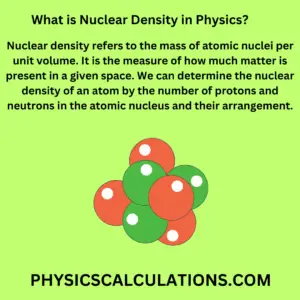What is Nuclear Density?
Nuclear density refers to the concentration of mass within the nucleus of an atom, expressed as mass per unit volume. It is an extremely high density compared to macroscopic matter, reflecting the compact nature of the nucleus where protons and neutrons are densely packed within a very small space. The average density of the nucleus of an atom is extremely high, typically on the order of 2.3 x 1017 kilograms per cubic meter.
What is Nuclear Density in Physics?
Nuclear density is a fundamental concept in nuclear physics that refers to the measure of the mass of atomic nuclei per unit volume. The understanding of nuclear density is very important in various scientific fields, including nuclear engineering, astrophysics, and particle physics. This article aims to provide a comprehensive guide to nuclear density, including its definition, measurement, and significance in nuclear physics.

What is Nuclear Density in Physics?
Definition of Nuclear Density in Physics
Nuclear density refers to the mass of atomic nuclei per unit volume. It is the measure of how much matter is present in a given space. We can determine the nuclear density of an atom by the number of protons and neutrons in the atomic nucleus and their arrangement.
Factors Affecting Nuclear Density
Several factors affect the nuclear density of an atom. These include the number of protons and neutrons in the atomic nucleus, the nuclear force between nucleons, and the size of the nucleus.
Measurement of Nuclear Density
1. Experimental Techniques for Measuring Nuclear Density
We can use different experimental techniques to measure nuclear density. These techniques include electron scattering, elastic scattering of nucleons, and nuclear resonance fluorescence.
2. Units of Nuclear Density
The unit that we can use to measure nuclear density is the nuclear saturation density. It is defined as the density at which the nuclear matter is in a state of equilibrium. The nuclear saturation density is approximately 2.3 x 1017 kg/m3.
Significance of Nuclear Density in Nuclear Physics
Nuclear Structure and Stability
The nuclear density plays a crucial role in determining the stability and structure of atomic nuclei. Therefore, we can determine the stability of a nucleus by the balance between the nuclear force that binds nucleons together and the electromagnetic force that repels positively charged protons.
Nuclear Reactions
The nuclear density also affects nuclear reactions. These reactions can be fusion and fission reactions. This is because, in nuclear fusion, two atomic nuclei combine to form a heavier nucleus. While in nuclear fission, a heavy nucleus splits into two lighter nuclei.
Astrophysics
Nuclear density is also significant in astrophysics. It plays a critical role in the formation and evolution of stars. Thus, the nuclear reactions that occur in the core of a star depend on the nuclear density and temperature.
Applications of Nuclear Density
1. Nuclear Energy
Nuclear density plays a crucial role in nuclear energy. We use it to determine the fuel enrichment required for nuclear reactors and the critical mass needed for nuclear weapons.
2. Medical Applications
We also apply the knowledge of nuclear density in the field of medicine. It can help in positron emission tomography (PET) scans, which use a radioactive tracer to create images of the body.
Conclusion
Finally, nuclear density is a crucial concept in nuclear physics. It helps in various scientific fields, including nuclear engineering, astrophysics, and particle physics. Therefore, understanding nuclear density is essential for studying the structure and stability of atomic nuclei, nuclear reactions, and the formation and evolution of stars. The measurement of nuclear density and its significance in nuclear physics makes it a vital area of study for researchers worldwide.
FAQs
- What is nuclear density? Nuclear density refers to the mass of atomic nuclei per unit volume. It is the measure of how much matter is present in a given space.
- What is the unit used to measure nuclear density? The unit used to measure nuclear density is the nuclear saturation density, which is approximately 2.3×10^17 kg/m^3.
- How is nuclear density measured? Several experimental techniques can measure nuclear density, including electron scattering, elastic scattering of nucleons, and nuclear resonance fluorescence.
- What is the significance of nuclear density in nuclear reactions? The nuclear density affects nuclear reactions, including fusion and fission reactions, by influencing the probability of nuclei.
You may also like to read:
Properties of Nuclei in Physics